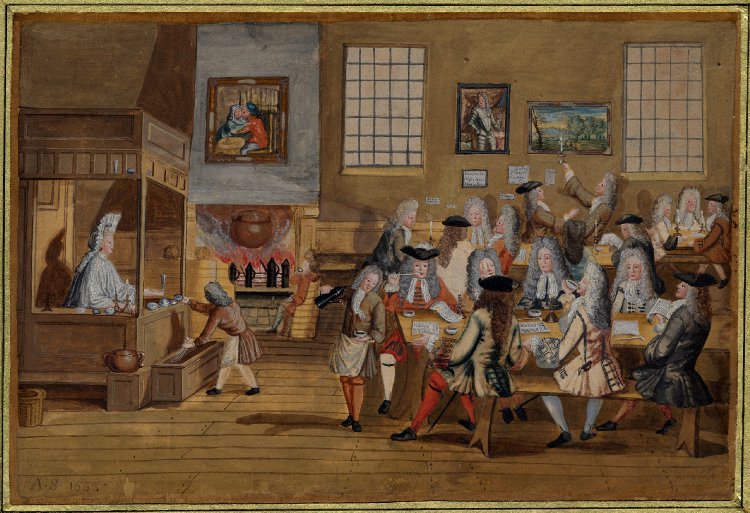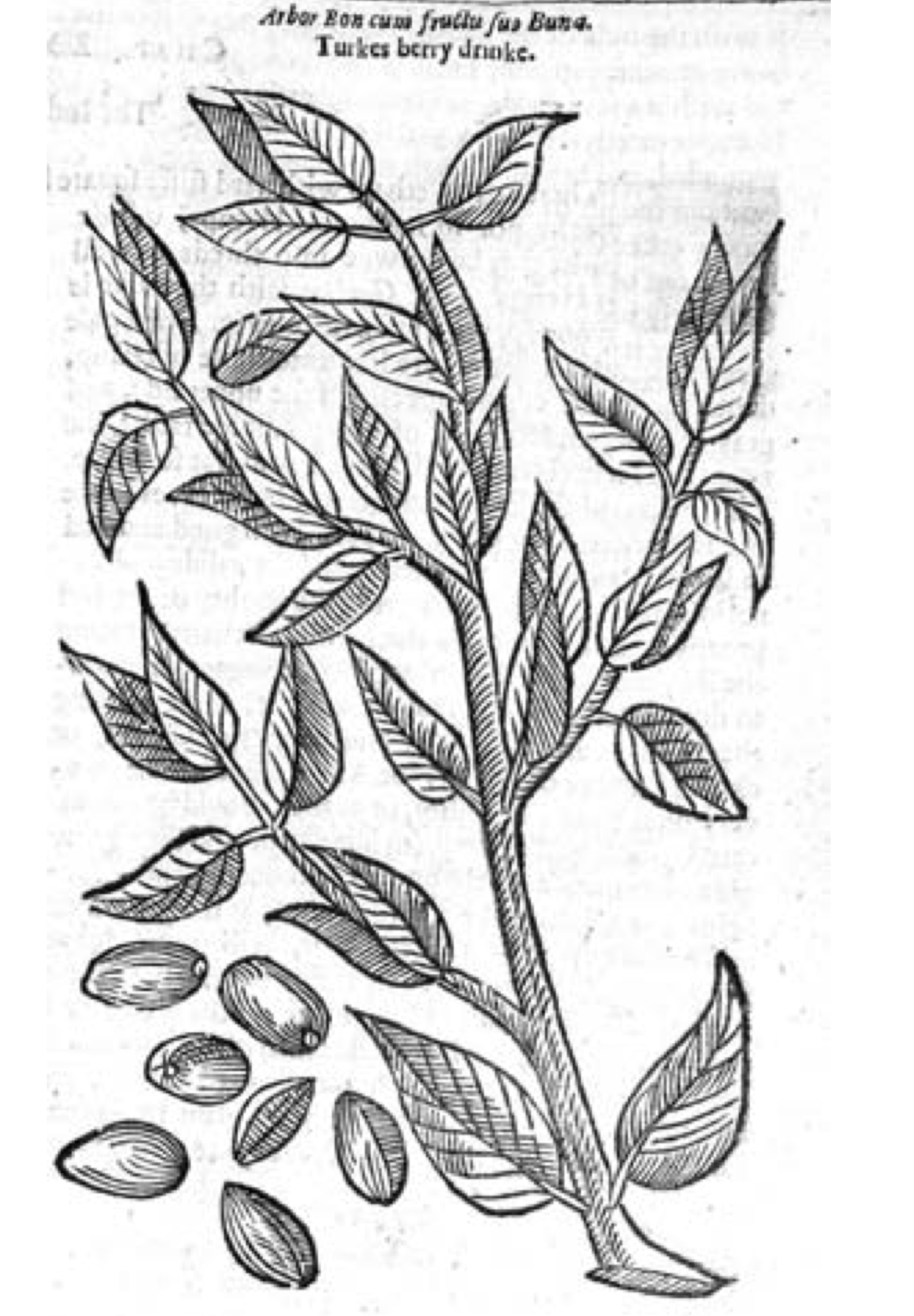CONTEXTUAL ANALYSIS ON HOW COFFEE DRINKING AFFECTED THE DEMAND OF THE CHINESE COFFEE POT
- HISTORY OF COFFEE DRINKING
- EARLY DOCUMENTATION OF COFFEE PLANT
- COFFEE DRINKING IN EUROPE
- REASONS FOR POPULARITY
- COFFEEHOUSE
- ROLE OF COFFEEHOUSES
- COFFEE DRINKING IN CHINA
HISTORY OF COFFEE DRINKING
Firstly, to begin my contextual analysis I will analyse from the general idea of a coffee pot into the details of its element. So I would start with a story of the invention of coffee. “Ethiopia is generally considered the birthplace of coffee. More than a thousand years ago, the story goes, a goat farmer named Kaldi noticed his herd dancing one day after gnawing on the red berries hanging from the bushes ringing the pastures. Tired himself one day, he decided to try the stuff. He perked up and started skipping along with his goats. Soon Kaldi made the berries part of his daily diet. One day, a monk from a nearby monastery spotted the farmer dancing with his goats. He, too, wanted some of that energy, not to shimmy but to stay up and study. Soon a fellow monk came up with the idea of boiling the beans and drinking the hot brew before lengthy religious services. News of coffee’s kick spread, and more and more monks throughout the African kingdom started drinking it to extend their devotion time.”
EARLY DOCUMENTATION OF COFFEE PLANT
As we learn about how plant is being documented throughout the history, the earliest pictorial representation of coffee plant was first found in John Parkinson’s Theatrum Botanicum (1640). In the last section, he devoted to ‘‘strange and rare plants,’’ on ‘‘the Turkes berry drinke,’’ coffee. His account was based on previous writings on the plant by Rauwolf, by Prosper Alpinus, a Venetian botanist, and by Paldanus’s commentaries on the English translation of the Dutch traveler Jan Huygen van Linschoten’s narrative of his observations in the East Indies. This image would soon find itself repeated in numerous later natural histories of coffee.
COFFEE DRINKING IN EUROPE
As the Chinese Coffee Pot was made for the market of Europe, I would like to analyse how the coffee was introduced there. Coffee and coffeehouses did not have a foothold in Europe until the second half of the seventeenth century, although Europeans, as is evident in travel accounts and medical treatises, had certainly been aware of this hot and exotic drink with a bitter taste, the rituals that surround it and the coffeehouses where it was primarily consumed since at least the late sixteenth century. Italian merchants introduced coffee beans to southern Europe in the early seventeenth century. By the early eighteenth century, coffee was known everywhere and there was hardly any big town across Europe without at least one coffeehouse. By 1734, 551 licensed coffeehouses in addition to a significant number of unlicensed ones had carved out an alternative place of public sociability in London. By the nineteenth century, coffee had established itself as the most prominent drink, dwarfing its past and recent rivals such as chocolate and tea, respectively, and the coffeehouse as the most ubiquitous place of sociability in large parts of Europe and the Middle East. Seeing the growing demand of coffee consumption, it can be said that the demand for coffee during the period of the Chinese Porcelain Pot (around 1735) was highly increasing in the Europe.
REASON FOR POPULARITY
The reason behind is part of a larger question of the diffusion and assimilation of foreign exotic ‘soft drugs’ such as tobacco, chocolate and tea in the early modern world in the age of early globalisation. Historians have now largely moved away from the biological essentialism that emphasises the tastiness of chocolate, addictiveness of tobacco and the medicinal properties of coffee or the economic determinism that highlights increasing commercialisation in the age of mercantilism as the primary cause for the diffusion and appropriation of these substances, toward cultural functionalism that gives primacy to the social context in which they were appropriated by local cultures.
COFFEEHOUSE
The popularity of coffee house made me want to research more into it. And follow are some paintings of the European coffeehouses in 1800s.



ROLE OF COFFEEHOUSES
After some research, the coffeehouse can be portrayed in two opposing point of view. One as a site for polite conversation as well as the quiet contemplation of the daily news or the latest political pamphlet. Another is where violent clashes of this sort were familiar in late seventeenth and early eighteenth-century coffeehouses.
The danger of coffeehouses can be shown implicitly and explicitly. Implicitly, it includes lies, rumors, and frivolous time-wasting within the polite coffeehouse conversation. While, explicitly is that coffeehouse civility might easily dissolve into mob violence. They were also well-founded fears and the coffeehouses were indeed a primary venue for the distribution of false rumors, seditious libels, and political organizing.
Analysing the coffeehouses images in the era, I realise that there is some kind of gender segregation. All the patrons of the coffeehouse are men. Through research, it was not that women were prohibited from entering any coffeehouse, it just that the activities commonly associated with coffeehouse society were considered to be traditionally masculine activities or responsibilities. Here the coffeehouse was promoted as a venue for male sociability that complemented.
Even though, there is a woman behind the bar and a boy as the server. It is as if implied that the role of women and children are less important than the men and that coffeehouse belongs for men. Does it mean that the demand of coffee pot is higher for men as the consumers are mostly men? How about the Chinese Coffee pot that seems to be feminine and made for women? Maybe, its export to Europe was not made for coffeeshops and was made for more either personal use or simply targeted at women.
COFFEE DRINKING IN CHINA
China’s first encounter with coffee occurred in the late 1800s, when a French missionary introduced it in Yunnan province, in the southwest of the country. The Chinese initially showed little interest in this drink favored by Westerners, except in places like the Western influenced city of Shanghai. But a hundred years after its first introduction to China, especially since the reform and opening up in 1980s, coffee became a popular drink in China.
Even though the coffee was a hype in Europe in the 1800s, apparently it was not really a thing in China. An interesting piece showing the exquisite drinks in the 1800s was made where the Arabian man drinks coffee, Chinese man drinks tea and the Indian man drinks chocolate.

In that way, even though the planting of coffee in China has been high, the consumption of it was not in demand in 1800s. Hence, the Chinese Coffee Pot was really made for European market demand in which it is likely that the making and consideration of the porcelain was not based on for local consumption but really to fulfil the European demand.
Next part: CONTEXTUAL ANALYSIS ON THE FORM, STYLE AND SHAPE OF THE CHINESE COFFEE POT
Previous part: INTRODUCTION
SOURCES AND REFERENCES
- Bayer, Jonathan. “Society at Auction: Coffee-House Culture in Occupied New York.” Journal of the American Revolution. November 04, 2016. Accessed November 06, 2018. https://allthingsliberty.com/2016/11/society-auction-coffee-house-culture-occupied-new-york/.
- BORSAY, PETER, and JAN HEIN FURNEE, eds.” Leisure Cultures in Urban Europe, C.1700-1870: A Transnational Perspective. Manchester: Manchester University Press, 2016. http://www.jstor.org.ezlibproxy1.ntu.edu.sg/stable/j.ctt18j8zcq.
- “Chapter 25: China.” A People’s History of Coffee and Cafes – Resources. Accessed November 6, 2018. http://www.blackapollopress.com/coffee/chapt25.html.
- COWAN, BRIAN. “An Acquired Taste.” In” The Social Life of Coffee: The Emergence of the British Coffeehouse, 16-30. Yale University Press, 2005. http://www.jstor.org.ezlibproxy1.ntu.edu.sg/stable/j.ctt1npc0p.7.
- COWAN, BRIAN. “Civilizing Society.” In” The Social Life of Coffee: The Emergence of the British Coffeehouse, 225-56. Yale University Press, 2005. http://www.jstor.org.ezlibproxy1.ntu.edu.sg/stable/j.ctt1npc0p.16.
- “Early History of Coffee Drinking.” Accessed November 03, 2018. http://www.web-books.com/Classics/ON/B0/B701/08MB701.html.
- GILMAN, CLARABEL. “COFFEE.”” The Journal of Education42, no. 10 (1043) (1895): 178-79. http://www.jstor.org.ezlibproxy1.ntu.edu.sg/stable/44042231.
- “Interior of a London Coffee-house. Anonymous. c. 1650-1750.” British Museum Images. Accessed November 06, 2018. https://www.bmimages.com/preview.asp?image=00207896001.
- International Coffee Orgaization. Coffee in China. Report. Vol. 115th Session. 115-7. Milan, Italy: International Coffee Council, 2015. Accessed November 6, 2018. http://www.ico.org/documents/cy2014-15/icc-115-7e-study-china.pdf.
- JURA Elektroapparate AG. “Coffee History.” China. Accessed November 6, 2018. https://cn.jura.com/en/about-coffee/coffee-history.
- KIRLI, CENGIZ. “Coffeehouses: Leisure and Sociability in Ottoman Istanbul.” In” Leisure Cultures in Urban Europe, C.1700-1870: A Transnational Perspective, edited by BORSAY PETER and FURNEE JAN HEIN, 161-82. Manchester: Manchester University Press, 2016. http://www.jstor.org.ezlibproxy1.ntu.edu.sg/stable/j.ctt18j8zcq.14.
- Simon, Bryant. “Sleeping Soundly in the Age of Globalization.” In” Everything but the Coffee: Learning about America from Starbucks, 201-38. Berkeley; Los Angeles; London: University of California Press, 2009. http://www.jstor.org.ezlibproxy1.ntu.edu.sg/stable/10.1525/j.ctt1pp5hm.11.
- “The Coffee House Politicians.” British Museum Images. Accessed November 06, 2018. https://www.britishmuseum.org/research/collection_online/collection_object_details.aspx?objectId=3072674&partId=1.
- Topik, Steven. “The World Coffee Market in the Eighteenth And Nineteenth Centuries, from Colonial To National Regimes.” May 2004. Accessed November 4, 2018. http://www.lse.ac.uk/Economic-History/Assets/Documents/Research/GEHN/GEHNWP04ST.pdf.
- “Travel Blog.” The China Guide. Accessed November 06, 2018. https://www.thechinaguide.com/blog/a-brief-history-of-coffee-in-china.
- WASSERSTROM, JEFFREY N., and Vladimir Tismaneanu. “All the Coffee in China.” In” China’s Brave New World: #NAME?, 20-27. Bloomington; Indianapolis: Indiana University Press, 2007. http://www.jstor.org.ezlibproxy1.ntu.edu.sg/stable/j.ctt2005w3z.7.
- Zhang Nan. “Coffee Market in China: Trends & Consumer Strategies.” A Coffee Industry Market Research of a Traditional Tea-Drinking Country, June 30, 2014. Accessed November 6, 2018. https://riunet.upv.es/bitstream/handle/10251/44210/Nan%20Zhang%20IIIIII.pdf.


